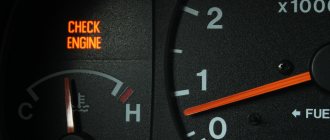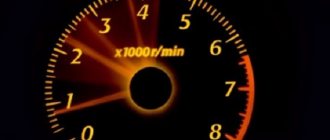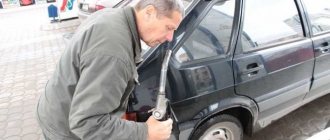Smooth acceleration is important for the comfort of a car ride. When your car jerks when accelerating, this indicates some kind of technical problem or damage. Today we'll tell you why your car may jerk when accelerating and what you can do to fix the problem.
To make it easier to detect the problem, you need to take into account the nature of the twitching. Does your car shake when you press the gas pedal hard? Check the mass air flow sensor. Do you feel like your car is lacking power? Dirty injectors may be the culprit. Let's take a quick look at the reasons why a car jerks when accelerating.
Bad spark plugs and/or coils
Sharp jerks during acceleration can occur when something is wrong with the fuel ignition. A faulty spark plug or failed ignition coil will cause misfire in one of the cylinders. This may cause slight jerking, especially when you are trying to accelerate.
In addition, unstable idling will be additional confirmation of problems with the spark plug or coil.
Conclusion
If the car jerks during acceleration or when driving at low speeds, the reasons may be defects in the fuel system, engine, gearbox, ignition or other components. To understand which systems require repair, you need to pay attention to the nature of the twitching, intensity and accompanying symptoms. To accurately determine the problem, it is advisable to carry out diagnostics in a workshop, especially if the owner does not have experience in repairing the car with his own hands or does not have the necessary tools.
Dirty throttle
Jerking when accelerating can also occur if the throttle valve is dirty. The car will lack power and may stall after you press the gas pedal once and then let it idle. You can use special products from auto stores to clean the throttle body, but be careful. Excessive throttle body cleaning in older vehicles can result in high engine idle speed due to wear on the throttle body. Sometimes minor repairs to this unit may be required.
Causes of overclocking failure
The next common problem with some engines is poor acceleration. The problem is relevant regardless of the type of internal combustion engine and the type of fuel consumed. What makes the situation easier is that motors that differ in design have their own unique and common disadvantages. Similar traits can be described together.
- The spark plugs do not fire correctly or the high-voltage wires are broken. To eliminate the failure, you need to check everything, right down to the coils. If the nodes are working normally, you need to move on.
- Filters are clogged. A common problem for all engines is clogging of the fuel supply and air lines. Obstacles may cause problems with dynamics.
- The ignition is set incorrectly - this can also cause jerks during acceleration.
Injector
Node problems:
- Decrease in fuel pump efficiency. Similar to the principle of diesel engines, gasoline is pumped into the ramp by an injection pump. If the performance of the device is not enough, a negative effect appears.
- The injectors are clogged. Fuel nozzles have a small outlet. If even a grain of sand gets in, the throughput is sharply reduced. As a consequence, the ensuing trouble.
- Problems with MRV and PDZ sensors. Worn out or damaged sensors transmit information to the “brains” late or completely incorrectly.
- ECU. The presence of errors or software glitches inside the device provokes such breakdowns.
Carburetor
It's a little easier with a knot.
- Damage inside the float chamber. A common cause is incorrect float setting. The chamber is responsible for maintaining a minimum fuel reserve for rapid acceleration. If its regulator is set incorrectly, the capacity is not fully filled and a failure occurs during acceleration.
- Throttle cable stretch. Some classic owners have a slightly loose gas pedal, therefore the response from the carburetor will not be quick.
- The fuel pump is not working. Low efficiency of the pump or its wear also directly affects the dynamics of the car.
Diesel
- The injection pump is damaged or clogged. Conventional diagnostics of the node helps correct the situation.
- The injectors are worn out or clogged. The problem is eliminated by diagnostics on the stand.
The car jerks on the gas
It happens that a car with installed HBO jerks at idle or during acceleration. At the same time, car enthusiasts often look towards gas. However, the problem is not always hidden here.
Idling
Gases have slightly different combustion parameters and working mixture proportions. In some cases, it is enough to calibrate the mixer and everything will fall into place.
The problem is not with HBO
In most cases, when pulling a car, HBO is not relevant. Problems encountered on a conventional carburetor or injector are relevant here.
Note! According to statistics, in 8 out of 10 cases the gas installation has nothing to do with the problem.
The problem is in HBO
If the reason lies in the gas installation, it should be looked for in air sucking into the system.
- At connecting pipes or highway joints. To find the problem, just treat all “suspicious” areas with a soap solution and see where the bubbles swell.
- Damage to the hoses themselves. Hoses can crack due to time and constant overheating.
- Suction through the installation site of the fitting (cotton). Here it is enough to tighten the connection.
- Cracking of the gearbox gasket. The part is often exposed to critical temperature changes, which can lead to its failure.
The mass air flow sensor (MAF) is faulty
If the MAF sensor sends incorrect information to the ECU, the air/fuel mixture may not be ok. It will either be too rich or too lean, causing the car to stall, jerk, shake and generally irritate the driver. The mass air flow sensor can be cleaned, but it usually requires replacement if such failures occur.
The appearance of jerking in the car when you sharply press the gas
If the cause is not related to the fuel pump, then these symptoms may indicate the so-called “triple” of the engine. A situation arises in a car in which out of 4 cylinders only one can work correctly. As a result of the “triple”, the engine simply cannot respond in time to pressing the gas pedal, after which similar problems arise. You can deal with the breakdown in the following ways:
- If the oxygen supply sensor is not working properly, the system is diagnosed using a multimeter. If any faults are found, it is simply replaced.
- If the valve timing in the engine is shifted, it is necessary, with the help of car service specialists, to adjust them according to the appropriate instructions.
- Detection of an incorrect glow number of spark plugs is resolved by installing a new set with the correct number.
- The problem of clogged injectors can only be solved at a car service center. To do this, they are installed on a special stand, which simulates the operation of a motor, and washed with a special solvent.
- The problem can also arise if the emulsion tube and well located in the design of the second chamber of the carburetor engine are clogged. The only solution here is to flush the carburetor and pipe with kerosene.
Dead catalyst
If the air-fuel mixture is too rich, it can cause the catalytic converter to fail because all the fuel is not burned in the chambers and ends up in the exhaust system and then ignites there. After just a short period of such operation, the catalyst will be blocked, and this will cause the car to jerk when accelerating due to poor air flow in the exhaust system. Cleaning the catalyst is possible, but in most cases it will need to be replaced.
What to do
If you lack knowledge or lack confidence in your own abilities, you can seek help from a service station, where specialists will conduct a diagnostic examination and repair the car.
If the user decides to figure it out on his own, he must do the following.
When I press on the gas, the car jerks and does not move.
In the case when the car behaves predictably at idle, and when the trigger is pressed, jerks are felt, and the car slowly picks up speed. The problem lies in the lean or over-enriched mixture entering the cylinders. It doesn’t matter whether it’s an old VAZ or a new modification like the Hyundai Accent. The original source is located here.
The secondary question is how this happens, because in 50% of cases the carburetor or injector is configured correctly.
The car jerks when accelerating and pressing the gas sharply
Similar symptoms occur on fuel-injected foreign cars - when the trigger is pressed firmly, the car jerks. In this case, acceleration occurs in normal mode. For cars such as Ford Focus, Opel Astra J, Chevrolet Cruze, the problem may be a breakdown of the ECU, mass air flow sensor, or TPS. The problem also does not avoid modifications of the VAZ 2114 and Audi A6 C5. The easiest way to diagnose is to replace parts with obviously new ones. Thus, the throttle position sensor may become “stupid”, incorrectly indicating to the ECU the location of this unit, which causes variable throttle opening with all the ensuing consequences. Also, the mass air flow sensor may incorrectly interpret the indicators, which will cause the mixture to become leaner.
When you press the gas pedal, the car stalls, then jerks sharply
When a vehicle stalls during acceleration, followed by a sharp jerk, and then the dynamics stabilize. The following items need to be checked:
- air line;
- accelerator pump;
- fuel quality;
- checkpoint;
- main fuel pump;
- ignition settings;
- MRV sensor.
Owners of the Lada Priora periodically face the problem of fuel pump failure. Here it will be enough to replace the element with a new one, to be on the safe side, clean the lines (low-quality fuel could get in).
Also, in some cases, the engine begins to stall and then accelerate. Here, the mass air flow sensor is checked, the spark plugs are diagnosed, the ignition angle is checked, and the injectors are clogged.
Additionally, if you have an automatic transmission, you need to check this mechanism. About 20% of visits to a car service center with similar faults end in “treating a surprise” inside the torque converter.
The car jerks while driving when the gas pedal is pressed lightly
A more exotic malfunction is when, when you smoothly press the trigger, the car begins to twitch until the power plant reaches a certain speed. There is a lack of combustible mixture in the float chamber of the internal combustion engine - gasoline burns faster than it can flow. This is a side effect of a faulty fuel pump; the unit does not have time to pump a new portion of the mixture, which provokes engine jolts.
Note! On independent designs like the carburetor Oka or the injection Lanos, the breakdown in 90% of cases manifests itself in the same way, which narrows the search area.
The car jerks when you press and release the gas
If, when the speed is reduced, the car begins to nod, and during acceleration it jerks again, there may be two sources of the problem.
- Sensor failure. Faulty sensors send incorrect data to the ECU, causing a disruption in the uninterrupted fuel supply.
- Clogged dosing elements (nozzles, jets). Owners of classic models such as the VAZ 2107 often encounter a similar problem. A clogged injector, after releasing the gas, “spits out” part of the fuel, which causes an increase in speed. During sudden acceleration, the element does not have time to supply the required amount of mixture to the cylinder.
Carburetor car jerks when you press the gas
If a problem is detected on carburetor vehicles such as VAZ 2109/2106. First of all, you need to pay attention to the fuel supply system . The design of standard Solex carburetors has outlet tubes designed to supply gasoline to the mixture formation chamber. By pouring low-grade fuel, thin channels can become clogged, which prevents its free passage. Usually the channel of the first chamber is clogged. If the engine jerks while gaining speed, and after reaching 2500-3000 rpm the acceleration proceeds smoothly - this is where the trouble lies. The defect is eliminated by purging the unit with compressed air and preliminary cleaning the jets (just in case).
It is also necessary to check the main pump (a problem with all classics), and the ignition timing.
When you press the gas, a car with an injection engine jerks
If the injection VAZ 2110 twitches, the search for the problem should start from the MVR, PDZ, and ECU sensors.
In this case, faulty sensors can send a false signal to the control unit, which is the primary source of the trouble. The next reason is clogged injectors. Symptoms usually appear 15-20 km after filling low-quality fuel into an empty tank.
The last point is failure, ignition interruptions. Spark plugs and armored wires are diagnosed.
Diesel car jerks when pressing gas
Regarding diesel engines, the solution to the problem is extremely simple - jamming of the moving blades of the main pump. The reason for this phenomenon is considered to be long-term downtime of transport in a damp place. It is moisture that oxidizes metal surfaces, which leads to jamming of the structure.
Failure repair is carried out by replacing the damaged part.
Dying fuel pump
Another part that can cause your car to jerk when accelerating is the fuel pump. If it is about to die, it may not be providing the optimal level of pressure to the fuel injection system. This will result in insufficient fuel delivery and jerking.
Diagnostics
The diagnostic procedure for different engine designs is performed according to a different algorithm.
However, there are general faults. During the process, it is necessary to check the fuel system, air supply lines, and ignition apparatus. In this case, troubleshooting is performed one by one for all units. If the sequence gives a result, the damaged node is replaced with a known good one (new).
Resolving identified problems
Once the cause has been identified, you can begin to eliminate it. In most cases, this work should be entrusted to specialists. After all, the reasons that at first glance were key are not always exactly what they are. Correct ignition tuning, carburetor adjustment, injector adjustment is something that is best entrusted to a knowledgeable person. If it was determined that the jerking was caused by dirty filters, then you can use an aerosol cleaner. It is sprayed into the air filter hole. Fuel tank additives also perform quite well. These additives clean the fuel line pipes and all other elements. XADO additives have proven themselves well.











